
As the 2025 New York Giants prepare to kick off their season against the Washington Commanders, we took a look back at the best players in the last 25 seasons who have landed on our version of the all-time best Giants roster, composed of players (starters and backups) who wore the Big Blue uniform at any point from the 2000 season onward.
Quarterbacks (2)
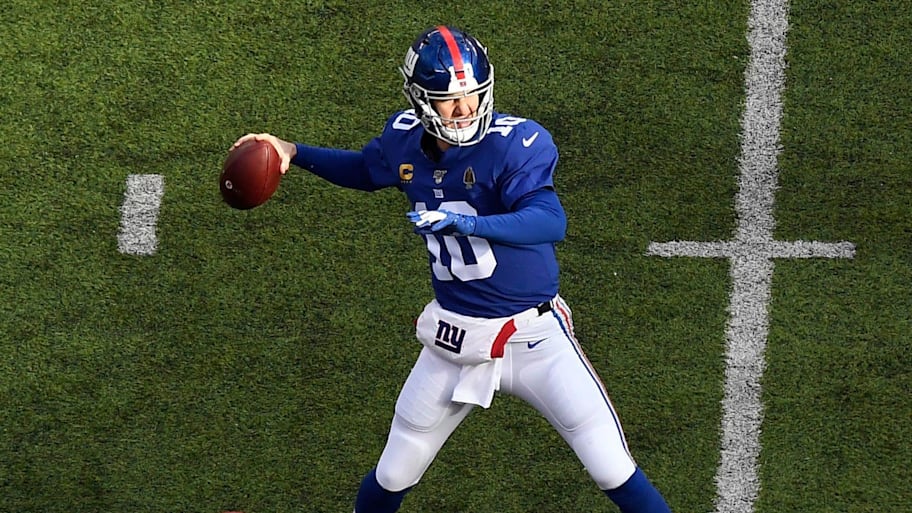
In one of the easier selections, Manning and Collins led the Giants to three of their five Super Bowl appearances, with two resulting in wins (XLII and XLVI, both led by Manning).
Running Backs (4)
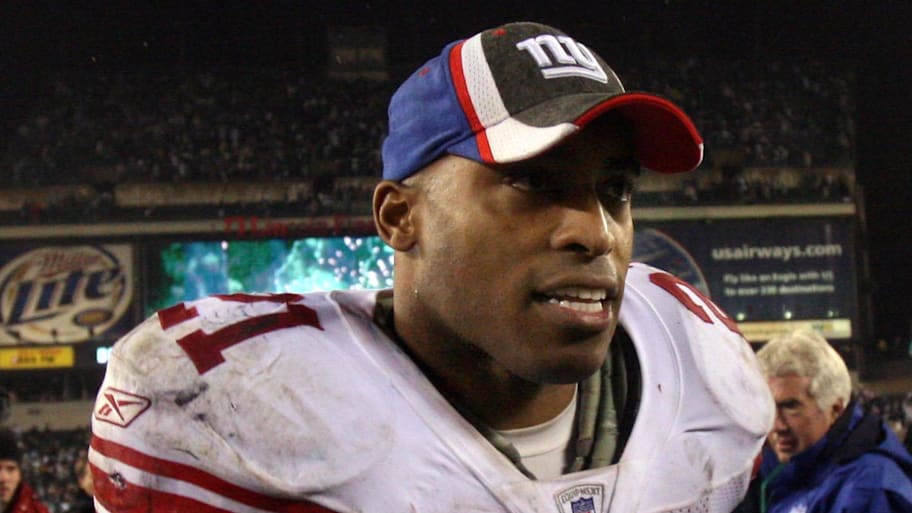
Barber recorded six 1,000-yard rushing campaigns during his 10-year Giants career, including five in a row between 2002-06 to close out his career. Barber still holds the franchise rushing records for career attempts (2,217), career yards gained (10,449), and most yards gained in a single game (234), just to name a few.
Barkley delivered three 1,000-yard rushing campaigns for the Giants, nearly making it four in his final season in Blue when he finished with 962 rushing yards. Barkley’s 1,312 rushing yards in 2022 and 1,307 yards in 2018 are the seventh and eighth-most rushing yards gained by a Giants running back in a season.
Jacobs was the last of the Giants’ big bruising backs (at least until Cam Skattebo came along). He posted back-to-back 1,000-yard rushing campaigns in 2007 and 2008, two seasons in which he finished 15th or higher in total regular-season rushing yardage.
Bradshaw, a quick-footed change-of-pace back (who unfortunately dealt with foot problems later in his career), also gave the Giants a pair of 1,000-yard rushing seasons, those in 2010 and 2012.
His 1,235 rushing yards in 2010 put him ninth in the team’s record books for most rushing yards gained in a season.
Fullbacks (2)
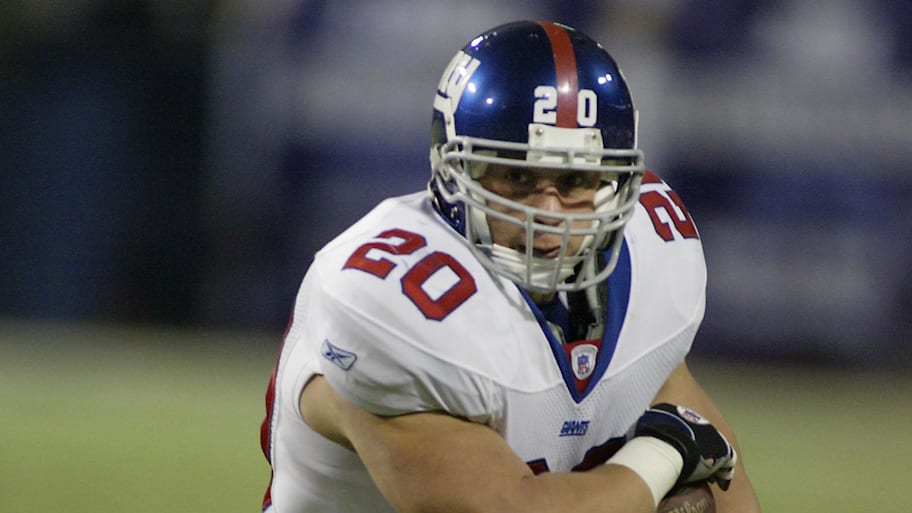
Finn was the fullback for Tiki Barber during the running back’s best seasons (2004-05) when Barber eclipsed the 2,000-yard all-purpose mark to lead the league in each of those seasons.
Hedgecock, a close second in this exercise, was not only part of the Super Bowl XLII championship team, but he was also an underrated lead blocker for a rushing offense that in 2007 was fourth in the league, and which, in the following season, finished first in the league in rushing with two 1,000 rushers (Jacobs and Derrick Ward).
Henry Hynoski (2011-14) did receive some consideration for this list, given that he was the lead blocker for a Super Bowl winner (XLVI). However, the 2011 Giants' rushing attack unfortunately finished last in the league that year – not Hynoski’s fault, but he was a part of that group.
Wide Receivers (6)
Except for Beckham and Hilliard, this group comprises receivers who were part of Super Bowl-winning teams.
Beckham sits fourth in the team’s record books for most pass receptions in career (390) and second in most yards gained in a game (222, Baltimore, 10/16/16). Although Beckham didn’t help the Giants win a Super Bowl, he was a key part of a team that made its first return to the postseason (2016) since the 2011 Super Bowl run.
Burress, who famously caught the game-winning touchdown in Super Bowl XLII, gave the Giants his second-best season with 1,214 yards in 2005, and proved to be the missing piece for a then-young Eli Manning, who made frequent use of his new skyscraper receiver in driving the Giants’ upward trend.
Cruz gets the nod as the slot receiver on this roster. A rags-to-riches story, Cruz posted two 1,000-yard receiving seasons in 2011 (the Super Bowl XLVI season) and 2012, earning second-team All-Pro honors in 2011 and a Pro Bowl berth in 2012. Sadly, a knee injury would ultimately cut short his career.
Toomer is the team record holder for most career pass receptions (668) and career receiving yards (9,497). He finished as the Giants’ receiving yardage leader from 2000 to 2003.
He also shares a postseason franchise record with Hakeem Nicks for being the only two Giants receivers with two or more touchdowns scored in a minimum of two postseason games.
Hilliard, whose career was marred by injuries, ranks seventh in franchise history in receptions (368) and tenth in receiving yards (4,630).
His best performance as a Giant might very well have come in the team’s 41-0 shutout of the Minnesota Vikings in the 2000 NF Championship game when he finished with a team-best 155 yards on 10 receptions (out of 13 targets) and two touchdowns, including a 46-yarder.
Nicks, who followed Burress as the team’s No. 1 receiver, is unfortunately another Giant who had some injury issues that got in the way of an otherwise productive career.
He recorded back-to-back 1,000-yard seasons in 2010 and 2011, his finest regular-season game coming on Sept. 12, 2010, against the Carolina Panthers, in which three of his four receptions that day were touchdown catches that helped the Giants to a 31-18 win.
But perhaps most important in Nicks’s career was his 2011 franchise-record setting postseason performance in which he finished with 28 receptions for 444 yards, four receiving touchdowns (also tied with running backs Joe Morris and Brandon Jacobs for most postseason touchdowns in franchise history), and most 100+ receiving yard games (3).
Tight Ends (2)
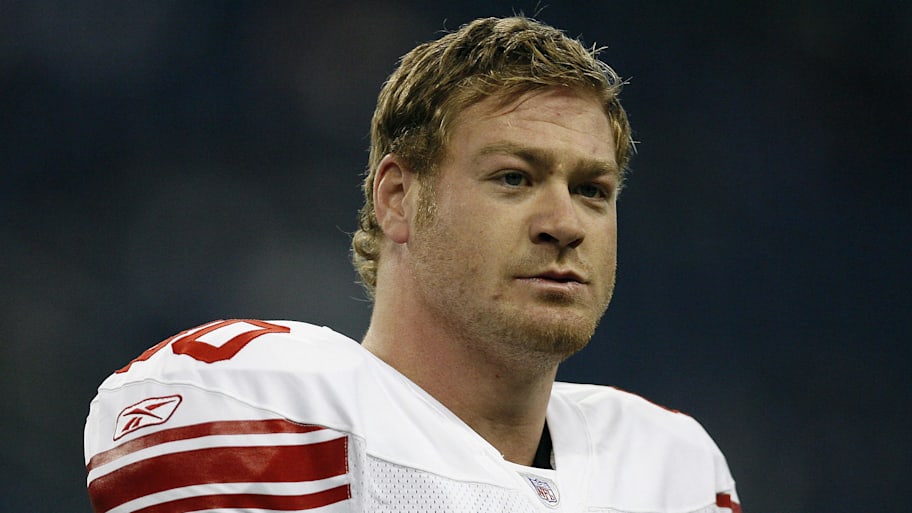
When it came to being an all-around tight end who could block and catch, Shockey was it–the best the Giants had since the days of Mark Bavaro.
Shockey never topped 1,000 receiving yards in his career with the Giants. Still, the four-time Pro Bowler, first-team All-Pro (2002), and second-place runner-up for the Offensive Rookie of the Year award finished twice as the Giants' team leader in receptions and receiving yards (2004 and 2006).
Unfortunately, due to a leg injury, he was unable to contribute to the Giants’ improbable postseason run.
Boss came to the Giants as a fifth-round draft pick out of Western Oregon, a part of the Giants’ amazing 2007 draft class.
Although he never topped 575 receiving yards at any point in his NFL career, the 6-foot-6 Boss, who became the team’s starting tight end after the Giants traded Shockey to the Saints, was an underrated yet key contributor during his time with the team, including the 2011 Super Bowl-winning season.
Offensive Line (10)
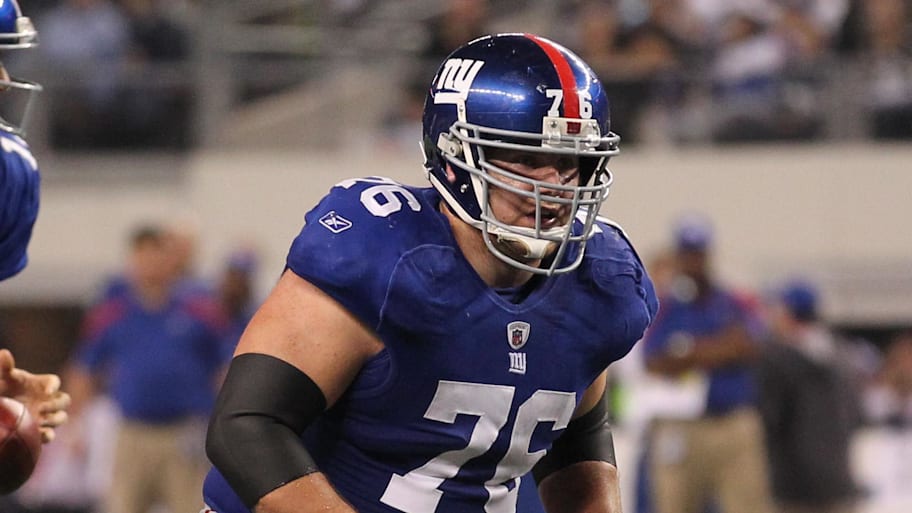
Despite Thomas’s recent injury woes, he gets the nod as our top choice at left tackle. When healthy, he’s an unmovable force and as solid a blocker as they come. Thomas earned a second-team All-Pro nod in 2022 in what has so far been his best and healthiest season.
Seubert was the very definition of scrappiness. An undrafted free agent out of Western Illinois who played his entire career with the Giants, this feisty player, who moved into the starting lineup at left guard by his second NFL season, overcame a horrific leg injury in October 2003, which many people feared would end his career before it could really get off the ground.
Five surgeries later, he was back on the field, initially as a tight end and backup lineman, before eventually finding his way back into the starting lineup, where he was a part of the 2007 Super Bowl championship team and one of the top NFL rushing attacks (2007 and 2008).
O’Hara was another rags-to-riches story. After going undrafted out of Rutgers, he declined a chance to sign with the Giants as an undrafted free agent, instead choosing Cleveland, where he played most of his snaps at guard.
Given a chance to join the Giants at center, his preferred position, he came into East Rutherford in 2004, just in time to usher in the new Eli Manning era at quarterback.
Unfortunately for O’Hara, he wasn’t the one who snapped the ball to Manning when the rookie made his debut–Chris Bober handled those duties as O’Hara was dealing with a staph infection that sidelined him temporarily.
O’Hara was not only part of the Super Bowl XLII championship team but was also named a second-team All-Pro in 2008 and a three-time Pro Bowl center, all of these honors coming as a member of the Giants.
When it came to value, look no further than Snee, a second-round pick out of Boston College in 2004. Snee, the son-in-law of Giants head coach Tom Coughlin, never took his position for granted, going about his daily responsibilities with the mentality of a player who was one play away from being cut.
He went on to contribute to two Giants Super Bowl championship teams. Snee was also named a first-team All-Pro in 2008, a two-time second-team All-Pro in 2009 and 2010, a four-time Pro Bowler, and a member of the 2004 PFWA All-Rookie team.
Snee, who these days is a Giants scout, is also a member of the team’s Ring of Honor.
McKenzie joined the Giants as an unrestricted free agent after spending his first four seasons with the Jets, who drafted him out of Penn State in 2001 in the third round.
Although McKenzie didn’t earn accolades over his career, during his prime, he was arguably one of the best right tackles in the league.
In 2005, he was instrumental in helping to block for running back Tiki Barber’s franchise record-setting 1,860 yards. McKenzie was also part of the Giants’ last two Super Bowl championships.
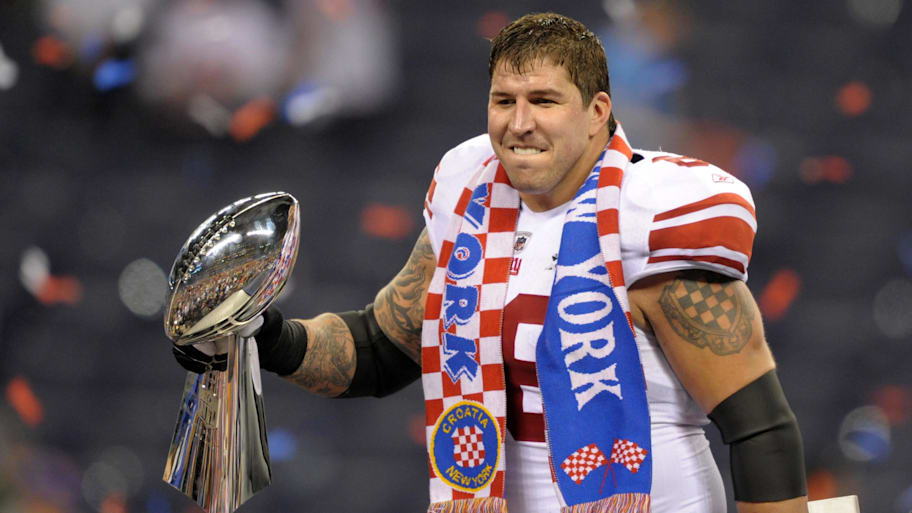
Zeigler stepped right into a Giants offensive line that went to the Super Bowl (XXXV). Although he did not receive any accolades, he was a solid technician who effectively orchestrated the offensive line.
His football career was cut short due to a knee injury, which required microfracture surgery after he appeared in just two games in 2002.
Diehl was Mr. Versatility for the Giants, a fifth-round draft pick out of Illinois who played his entire 11-year career with the Giants and who was part of two Super Bowl-winning offensive lines.
Stone, a rare type of free-agent signing for the Giants, turned out to be well worth the gamble the Giants took on him in free agency.
Stone, who was primarily a backup guard and tackle for the Cowboys, was a restricted free agent who accepted a reported 5-year, $10 million contract with the Giants.
The Cowboys declined to match the offer and received a fourth-round draft pick as compensation.
Although he was relatively unproven with the Cowboys because he hadn't started at the NFL level, then-Giants general manager George Young saw the talent and was rewarded as Stone became a rock on the Giants’ offensive line, earning two Pro Bowl berths and two All-Pro Team nods.
Pugh, the Giants’ first “premium” draft pick (Day 1 or Day 2) at offensive line since the selection of tackle Will Beatty (Round 2, 2009), played most of his career snaps at left guard, but he was versatile enough to play anywhere on the line except for center.
Eluemunor gets our nod as the backup right tackle on this commemorative squad, as he’s solidified the position for the current team.
Defensive Line (8)
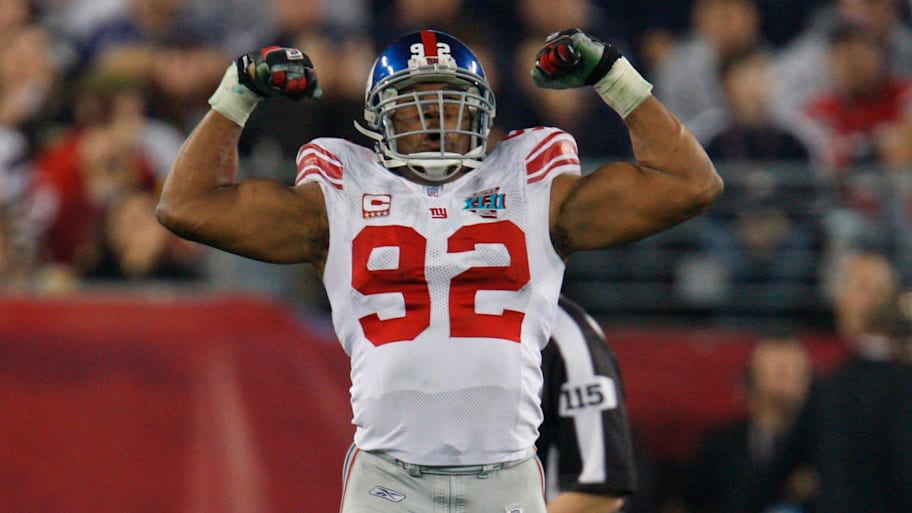
Just as Eli Manning was a no-brainer at quarterback, Hall of Fame defensive end Michael Strahan, who initially broke the NFL single-season sack record in 2001 (22.5) and was named the NFL Defensive Player of the Year, was a no-brainer choice for the defensive line.
Strahan’s muse, Osi Umenyiora, was another clear choice for the starting defensive line on this special roster.
Umenyiora, who in the first five seasons of his career earned two Pro Bowl nods and was voted a first-team All-Pro, missed the 2008 season with a torn meniscus.
He came back stronger than ever, going on to lead the league in forced fumbles (10) and nailing down a second-team All-Pro nod in 2010. Umenyiora’s 75 career sacks rank fourth in the team’s career record books.
Giants fans will likely remember defensive tackle Keith “The Hammer” Hamilton for his training camp battles with offensive lineman Rich Seubert.
Still, this fourth-round draft pick in 1992 might have been the “Dexter Lawrence” of his day–a fierce competitor who was a master against the run and who was a pass rush threat.
Hamilton’s 63.0 career sacks currently rank fifth on the Giants’ annuals.
Dexter “Sexy Dexy” Lawrence has morphed into a fan favorite, and not just because of his catchy nickname or youthful jubilance. Lawrence simply defies the laws of physics with his ability to move like a smaller man.
Having shown flashes of the greatness that was to come, starting in 2022 when he recorded 9.0 sacks in his first three seasons, the decision to move him to nose guard in 2022 really opened things up for this big-time run stuffer and pass rusher.
Over the last three seasons, Lawrence has recorded 21.0 sacks, including a career high of 9.0 sacks last season, his first NFL campaign in which he had to miss time due to injury.
Jason Pierre-Paul was the last of the Giants' homegrown pass rushers for a while, but he was a good one.
Drafted 15th overall in 2010, Pierre-Paul earned two Pro Bowls and one first-team All-Pro honor within his first three seasons in the NFL. He also notched double-digit sack campaigns twice as a Giant, in 2011 (career-high 16.5) and 2014 (12.5).
It’s hard to believe that the Giants got Justin Tuck in the third round of the 2005 NFL draft, but there’s no doubt that Tuck, a team captain, brought tremendous value.
He allowed defensive coordinators to play him at end during running plays and then inside at tackle on pass-rushing situations, where he would log the majority of his 66.5 career sacks.
Fred Robbins might be the only one in this position who might send Giants fans searching for more information, but he made quite an impact on the Giants' defensive line. Robbins was a second-round draft pick by the Vikings, who had modest numbers with Minnesota.
After signing with the Giants in 2004 on a six-year, $20 million deal, Robbins, who missed just three games during his stint in blue, delivered a steady stream of production for the Giants.
In 93 games (78 starts), Robbins recorded 25 sacks, 220 tackles, 52 tackles for loss, and 38 quarterback hits.
The Giants’ mid-year acquisition of Leonard Williams via trade from the Jets might have irked a few Giants fans at the time, considering some viewed Williams as a “rental” given his contract status. Still, Williams proved to be worth the trade.
Like Tuck, Williams was a hybrid defensive end/defensive tackle, and that versatility allowed Williams to produce 22.5 sacks over five seasons with the Giants.
Outside Linebackers (3)
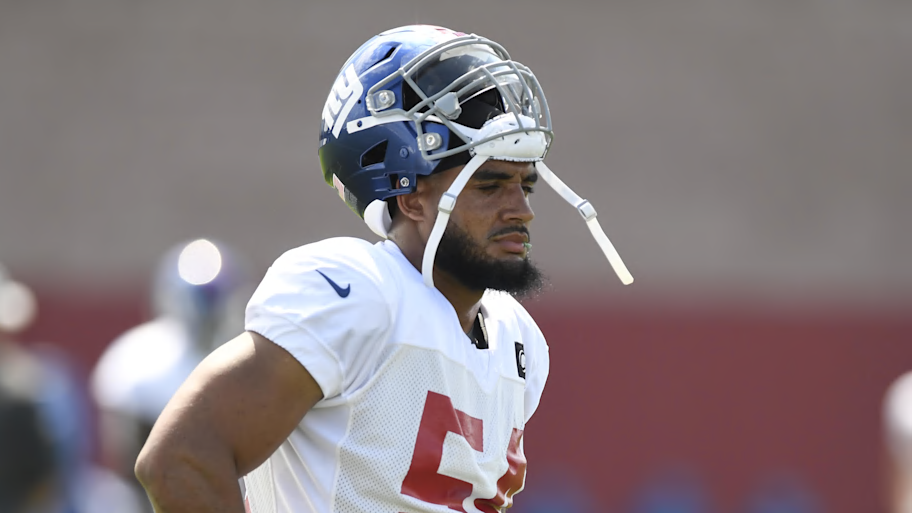
Jessie Armstead was the very face of a value pick. Selected in the eighth round of the 1993 draft–the last NFL draft that went eight rounds–Armstead not only developed into a team captain, but he was a pretty special player who could do it all.
Armstead was elected to five consecutive Pro Bowls from 1997 to 2001. He also earned first-team All-Pro honors in 1997, a year in which he was the third runner-up in the Defensive Player of the Year voting, and he was named second-team All-Pro in 1999 and 2000.
In 1999, Armstead led the NFL in tackles for loss with 21. He appeared in 144 games as a Giant with 98 starts and recorded 12 interceptions, 13 pass breakups, 11 forced tackles, 30.5 sacks, 778 tackles, and 45 tackles for loss.
Although Vernon was listed as a defensive end, he spent over 4,400 snaps outside where the team deployed his pass-rushing skills.
Vernon, who signed with the Giants as a free agent in 2016, went on to start in all 39 games in which he appeared as a Giant, logging 131 tackles, 22 sacks, 56 quarterback hits, and reaching a Pro Bowl berth in 2018.
Kiwanuka’s career path took an interesting turn. A first-round draft pick in 2006, he began his career as a defensive end before being converted to outside linebacker for the 2011-12 seasons (in 2008, he worked at outside linebacker during training camp before moving back to defensive end).
As an outside linebacker, Kiwanuka appeared in 36 games with 20 starts and recorded 121 tackles, 19 tackles for loss, 14 quarterback hits, one interception, two pass breakups, and 6.5 sacks.
Inside Linebackers (4)
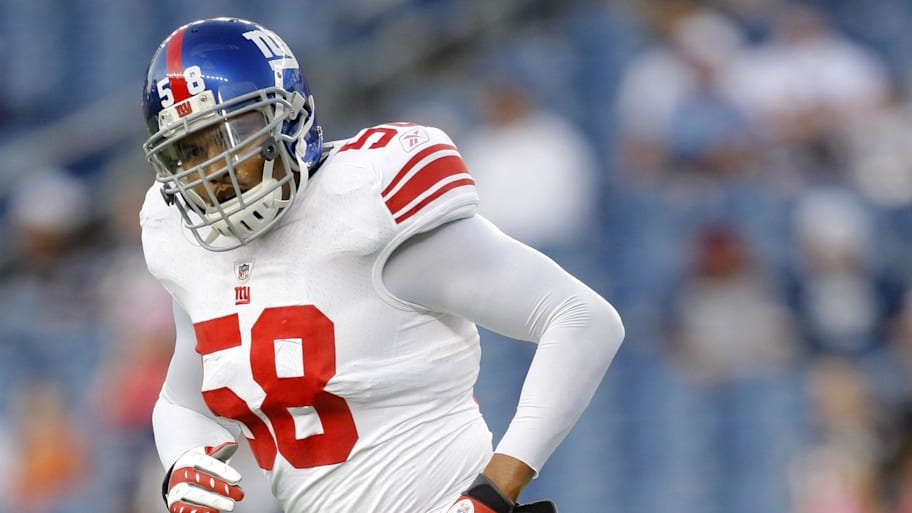
You couldn’t have asked for a better or more cerebral inside linebacker to have on the team than Antonio Pierce.
An undrafted free agent who set out to show the rest of the league who had passed on him in the 2001 draft, Pierce’s uncanny ability to diagnose plays before they even ran was an invaluable skill, as was his leadership ability.
Pierce earned a Pro Bowl berth in 2007 and a Super Bowl ring the following year, both with the Giants. He was forced to retire after the 2009 season due to a neck injury. He finished his Giants career with 491 tackles, 33 pass breakups, 11 quarterback hits, and 34 tackles for loss.
Micheal Barrow was only with the Giants for four seasons (2000-2003), the 2000 season being Super Bowl XXXV, but they were quality seasons.
During that stretch, Barrow recorded 488 tackles (346 solos), 45 tackles for loss, 16 pass breakups, 10 forced fumbles, and one interception–his best numbers among the four teams (Giants, Houston, Carolina, and Dallas) he played for.
Bobby Okereke has only been with the Giants for two seasons and, admittedly, is coming off a down year in 2024 that was cut short by injury, but Okereke has still found a way to deliver quality football.
In two seasons with the Giants–he played his first four years with the Colts–his 242 tackles are more than half of what he racked up in Indianapolis. He also has 20 career games with 10+ tackles, and seven games in which he has at least two tackles for loss.
Chase Blackburn might be best known to Giants fans for his special teams prowess, but when it came to playing linebacker, the Giants had in him another cerebral player who always had the defense lined up correctly.
The undrafted free agent’s fourth-quarter interception of a Tom Brady pass intended for tight end Rob Gronkowski early in the fourth quarter of Super Bowl XLV snuffed out a Patriots scoring drive that had breached Giants territory.
The play made Blackburn, who came off his couch toward the end of the regular season when the Giants started having injuries at linebacker, one of the unsung heroes of that game — a redemption play for an earlier penalty in which he was flagged for being the 12th man on the field.
Safeties (4)
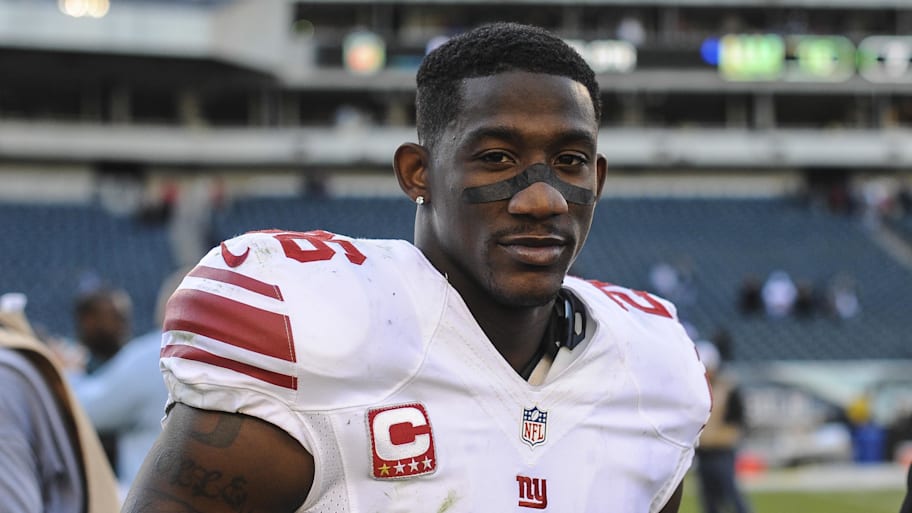
Antrell Rolle, originally a cornerback when he first came to the NFL in 2005 with the Cardinals, joined the Giants as a free agent in 2010 and instantly made a difference in the team’s defensive secondary.
Rolle, named the team’s starting free safety, recorded two of his best seasons as a Giant, earning two Pro Bowl honors and two second-team All-Pro nods.
He was also part of the 2011 Super Bowl team and, as a team captain of that squad, was instrumental in rallying the troops to finish on a strong note that season.
Landon Collins, a second-round draft pick for whom the Giants moved up to the top of the second round to acquire, earned the starting free safety role as a rookie and never looked back as far as being part of the starting defense.
His best season came in 2016 when he moved back to strong safety, his natural position.
That 2016 season marked the first of three straight seasons in which Collins earned Pro Bowl honors. In 2016, he was also named a first-team All-Pro and finished in third place for the Defensive Player of the Year honors.
In that season, Collins also became the first safety since Troy Polamalu to earn Defensive Player of the Week honors in back-to-back games.
He finished his Giants career having played in 65 games with 60 starts and recording 452 tackles, nine interceptions, 23 tackles for loss, and 34 pass breakups.
Gibril Wilson, a fifth-round draft pick in 2004, had a rather nondescript regular-season career for the Giants, having started 51 out of 52 games and recording 11 career interceptions and 27 pass breakups in his four seasons in blue.
But when it came to the 2007 postseason, that’s where he really raised his game. Wilson, in Super Bowl XLII, played in a team high 70 snaps, tied with cornerback Aaron Ross and inside linebacker Antonio Pierce.
Wilson finished with a team-best 86.6 mark on defense and a stellar 84.1 coverage grade, the best of any player on either team.
James Butler was never a flashy type of player who recorded gaudy-looking stats. But the one thing he did offer, which defensive coordinator Steve Spagnuolo highly appreciated during the team’s 2007 Super Bowl run, was a very high playing IQ.
In the Giants’ first Super Bowl win over the Patriots, Butler led the team with 10 tackles.
The one-time undrafted free agent took on the starting safety role in Spagnuolo’s defense in 2007 after primarily playing in the dime in his earlier seasons.
Butler recorded 191 tackles (153 solo), six interceptions, and 32 pass breakups for the Giants over his time in Blue.
In addition to his play on defense, he was a valuable member of the special teams units.
Cornerbacks (4)
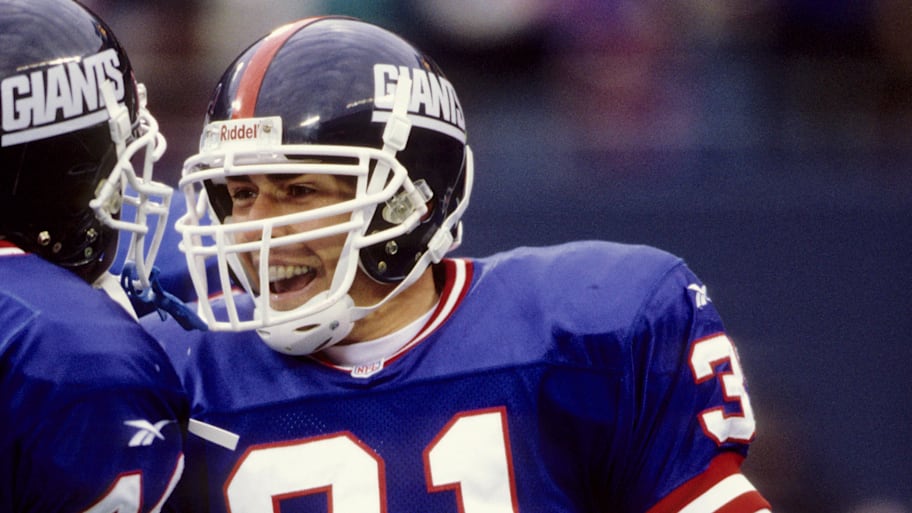
Corey Webster is the very definition of resilient. A two-time Super Bowl champion with the Giants (XLII and XLVI), the team’s second-round pick in 2005 struggled through his first two seasons to crack into the defensive lineup, relegated to special teams or the bench during his first two seasons.
That is, until Steve Spagnuolo came in as the defensive coordinator and figured out how to get the most out of the former LSU corner.
Webster, who played his entire nine-year career with the Giants, started 93 out of 121 games and recorded 20 career interceptions, including a career best six in 2011.
He also broke up 87 passes, forced seven fumbles, and logged 375 tackles, but in terms of some of his finest performances, those came in the postseason.
In the 2007 Wild Card game against the Bucs, he intercepted a pass by Jeff Garcia and recovered a fumble by a Bucs receiver that the Giants converted into a field goal.
Against Dallas, he held future Hall of Fame receiver Terrell Owens to three receptions out of six pass targets for 29 yards, one yard after catch, and one touchdown, a performance that also saw Webster force a drop by Owens and break up one pass.
Then, in the NFC title game, Webster became the answer to the trivia question, “Who was the last player to catch a pass from Brett Favre as a Packer?” when he picked off Favre’s final pass as a Packer.
There’s no telling how high Jason Sehorn’s career might have soared had it not been for his insistence that he return kickoffs during the opening kickoff of the 1998 preseason.
Sehorn, unfortunately, tore up his ACL and MCL and missed that entire season, never quite being the same player he was prior.
The Giants’ second-round draft pick in 1994 was blessed with above-average speed and athleticism. In the four years before his devastating injury, he recorded 11 of his career 19 interceptions, eight of his ten forced fumbles, and 190 of his 443 tackles.
In the Giants’ 41-0 shutout of the Vikings in the 2000 NFC Championship game, Sehorn had one of the Giants’ three interceptions on the day and also broke up three passes while finishing the game with two solo tackles in what was one of the finest individual postseason performances by a Giants defender that season.
Dominique Rodgers-Cromartie came to the Giants as an unrestricted free agent following a season in Denver and was instantly anointed the team’s No. 1 cornerback, succeeding Corey Webster in the role.
As a member of the Giants, Rodgers-Cromartie earned the second of his two career Pro Bowl berths (2015) and a second-team All-Pro nod in 2016, the latter season seeing him match his single-season career high in interceptions (six).
Rodgers-Cromartie also recorded 193 of his 455 career tackles as a Giant, and had a career best nine tackles for loss to go along with 47 pass breakups and 11 interceptions.
Aaron Ross was the headliner of the Giants’ 2007 rookie draft class, one of the best classes the franchise had in a while, given how every member of that class went on to contribute in some way to the franchise’s Super Bowl championship that season.
Ross was one of the biggest contributors. In four postseason games, he delivered 12 tackles (nine solo efforts) and two tackles for loss with one pass breakup.
Ross not only contributed to the team’s last two Super Bowl championships (XLII and XLVI), but he was a productive cornerback for Big Blue in the regular season.
He recorded 11 career interceptions (two returned for touchdowns), 38 pass breakups, 204 tackles, 10 tackles for loss, and eight quarterback hits as the team’s top cornerback.
Special Teams (4)

Lawrence Tynes, the Scottish-born kicker the Giants acquired in a trade with the Chiefs, will be forever revered as the man who kicked the Giants into their last two Super Bowl berths.
In 2007, after converting his first two attempts, he went on to miss two in the fourth quarter, one a result of a wobbly snap. But he came through for his team in overtime, nailing a 47-yarder in the cold to send the Giants to Super Bowl XLII.
In 2011, he repeated the feat–sort of–by sending a 31-yard field goal through the uprights in overtime to give the Giants a 20-17 win over the 49ers.
The irony of this field goal was that the Giants were penalized on the first attempt, which actually worked to their favor, as on the rain-soaked Candlestick Park field, the spot was moved back five yards, away from a muddy puddle and onto more solid ground, ensuring a smoother operation.
Feagles, who earned his second Pro Bowl berth as a member of the Giants in 2008, was the master of coffin corner and directional punting.
An iron man who played in a record 353 career games and who also set a record for most punts placed inside the 20 in his career (497), Feagles played for the Giants until his 43-year-old body just couldn’t hold up to the demands of the job anymore, the punter retiring after the 2009 season.
Harris joined the Giants as a free agent after three seasons in Dallas, earning a Pro Bowl nod as a Giant in 2016. In 2018, he led the league with a 14.1 yards per punt return average, and his 99-yard punt return for a touchdown against the Raiders was also tops in the league that season.
Harris finished his Giants career in 2017, having returned 70 punts for 559 yards and one touchdown, and 53 kickoff returns for 1,352 yards and a touchdown.
When it came to covering punts, Zac DeOssie, the team’s long snapper, was almost always the first man down the field.
A linebacker by trade, drafted in the fourth round of the 2007 draft, DeOssie followed in his father, Steve’s, footsteps, morphing from a linebacker into a stellar long snapper/special teams player.
The younger DeOssie earned two Pro Bowl nods, in 2008 and 2010, and posted three seasons for the Giants in which he had at least 10 total special teams tackles.
What happens next with the NY Giants? Find out! Follow and like us on Facebook. Visit our YouTube channel for the latest videos. Want to send a question in for our mailbag? You can do so here.
More must-reads:
- 49ers in trouble with superstar landing on injured reserve
- NFL decides on Jalen Carter punishment for spitting on Dak Prescott
- The 'Two passing and rushing touchdowns NFL games' quiz
Breaking News
Trending News
Customize Your Newsletter
 +
+
Get the latest news and rumors, customized to your favorite sports and teams. Emailed daily. Always free!








